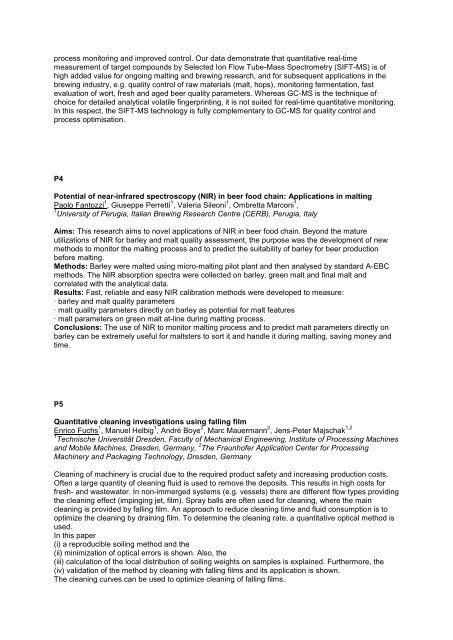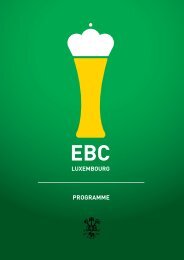here - the 34th European Brewery Convention
here - the 34th European Brewery Convention
here - the 34th European Brewery Convention
Create successful ePaper yourself
Turn your PDF publications into a flip-book with our unique Google optimized e-Paper software.
process monitoring and improved control. Our data demonstrate that quantitative real-time<br />
measurement of target compounds by Selected Ion Flow Tube-Mass Spectrometry (SIFT-MS) is of<br />
high added value for ongoing malting and brewing research, and for subsequent applications in <strong>the</strong><br />
brewing industry, e.g. quality control of raw materials (malt, hops), monitoring fermentation, fast<br />
evaluation of wort, fresh and aged beer quality parameters. W<strong>here</strong>as GC-MS is <strong>the</strong> technique of<br />
choice for detailed analytical volatile fingerprinting, it is not suited for real-time quantitative monitoring.<br />
In this respect, <strong>the</strong> SIFT-MS technology is fully complementary to GC-MS for quality control and<br />
process optimisation.<br />
P4<br />
Potential of near-infrared spectroscopy (NIR) in beer food chain: Applications in malting<br />
Paolo Fantozzi 1 , Giuseppe Perretti 1 , Valeria Sileoni 1 , Ombretta Marconi 1 ,<br />
1 University of Perugia, Italian Brewing Research Centre (CERB), Perugia, Italy<br />
Aims: This research aims to novel applications of NIR in beer food chain. Beyond <strong>the</strong> mature<br />
utilizations of NIR for barley and malt quality assessment, <strong>the</strong> purpose was <strong>the</strong> development of new<br />
methods to monitor <strong>the</strong> malting process and to predict <strong>the</strong> suitability of barley for beer production<br />
before malting.<br />
Methods: Barley were malted using micro-malting pilot plant and <strong>the</strong>n analysed by standard A-EBC<br />
methods. The NIR absorption spectra were collected on barley, green malt and final malt and<br />
correlated with <strong>the</strong> analytical data.<br />
Results: Fast, reliable and easy NIR calibration methods were developed to measure:<br />
· barley and malt quality parameters<br />
· malt quality parameters directly on barley as potential for malt features<br />
· malt parameters on green malt at-line during malting process.<br />
Conclusions: The use of NIR to monitor malting process and to predict malt parameters directly on<br />
barley can be extremely useful for maltsters to sort it and handle it during malting, saving money and<br />
time.<br />
P5<br />
Quantitative cleaning investigations using falling film<br />
Enrico Fuchs 1 , Manuel Helbig 1 , André Boye 2 , Marc Mauermann 2 , Jens-Peter Majschak 1,2<br />
1 Technische Universität Dresden, Faculty of Mechanical Engineering, Institute of Processing Machines<br />
and Mobile Machines, Dresden, Germany, 2 The Fraunhofer Application Center for Processing<br />
Machinery and Packaging Technology, Dresden, Germany<br />
Cleaning of machinery is crucial due to <strong>the</strong> required product safety and increasing production costs.<br />
Often a large quantity of cleaning fluid is used to remove <strong>the</strong> deposits. This results in high costs for<br />
fresh- and wastewater. In non-immerged systems (e.g. vessels) t<strong>here</strong> are different flow types providing<br />
<strong>the</strong> cleaning effect (impinging jet, film). Spray balls are often used for cleaning, w<strong>here</strong> <strong>the</strong> main<br />
cleaning is provided by falling film. An approach to reduce cleaning time and fluid consumption is to<br />
optimize <strong>the</strong> cleaning by draining film. To determine <strong>the</strong> cleaning rate, a quantitative optical method is<br />
used.<br />
In this paper<br />
(i) a reproducible soiling method and <strong>the</strong><br />
(ii) minimization of optical errors is shown. Also, <strong>the</strong><br />
(iii) calculation of <strong>the</strong> local distribution of soiling weights on samples is explained. Fur<strong>the</strong>rmore, <strong>the</strong><br />
(iv) validation of <strong>the</strong> method by cleaning with falling films and its application is shown.<br />
The cleaning curves can be used to optimize cleaning of falling films.





